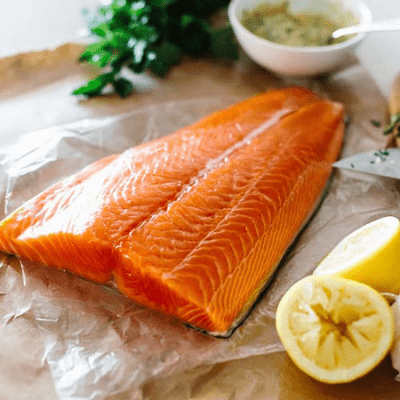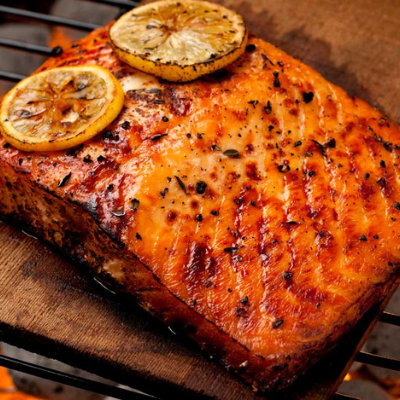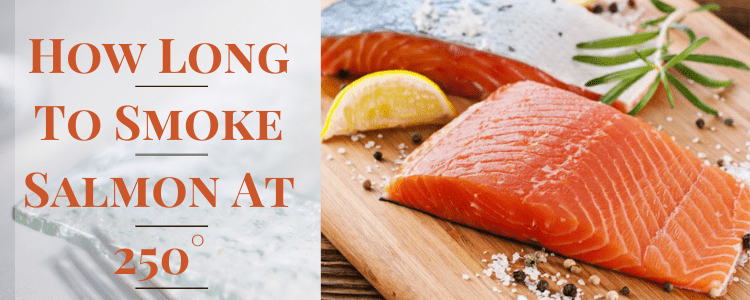Salmon is a common choice for millions of people worldwide, even though the verdict is still out on whether it is the tastiest fish to have swum the seas. It is not only delicious but also meaty and straightforward to prepare. A salmon fillet is a pleasant and appreciated dish on any occasion, whether you want to grill, panfry, smoke, or even eat it raw.
Salmon, in particular, can be easily smoked. It is the trick to know how long it should smoke and at what temperature. This article will teach you how long to smoke salmon at 250 degrees, the best temperature to smoke fresh salmon at, and a straightforward, step-by-step guide on how to smoke salmon properly.
How Long to Smoke Salmon at 250°
The salmon must be smoked at 250°F for 45 to an hour. The exact time will depend on the filet’s thickness and how cold it was when it was placed on the smoker. If cooking takes an hour, don’t be shocked. When salmon flakes readily with a fork, it is cooked. The fish should now have an internal temperature of at least 145°F.
What do you need to Smoke Salmon Properly?

The best thing about smoking salmon is how simple and easy it is to do. Perhaps everything you need to smoke salmon successfully is already in your kitchen cupboard. This comprises:
- Salt
- Brown sugar
- Black pepper
- Plastic wrap
- 2 baking sheets
Depending on the smoked salmon recipe you select, you might also need to fill your pantry with items like soy sauce, a dry brine, applewood chips for the smoky flavor, cream cheese, olive oil, aluminum foil, and fresh dill, and any marinades you might want to use. Of course, salmon and a smoker are also necessary. Your choice of a smoker is just a reflection of your skill as a grill master.
How to Smoke Meat in an Electric Grill?
Why Smoke Salmon at 250 Degrees?
Finding the ideal smoking temperature is essential when smoking anything, whether salmon or pork, to ensure that the meat is thoroughly cooked without needing to smoke it for days. Your salmon will take longer to smoke if you set the temperature lower.
However, despite cooking meat more quickly, greater smoking temperatures often risk drying it out. Why then would you smoke fish at 250 degrees? Because it uses the proper amount of heat, you can get well-cooked, juicy salmon without smoking it for a week.

How long to Smoke Salmon at 250 Degrees?
Expect salmon to spend roughly 60 minutes in the smoke for every pound of meat it contains when smoking it at 250 degrees. So, add around 60 minutes to the fish’s weight. Remember that larger salmon pieces will cook faster per pound and should be evaluated by interior temperature.
- If you have a 2-pound fish fillet, plan on smoking it for about 120 minutes to 2 hours.
- Expect a 6-pound salmon fillet to be finished in less than 300 minutes or 5 hours.
Check the internal temperature of the fish using a meat thermometer to ensure it is at a beautiful 160 degrees or until the fish begins to flake nicely.
How to Pick A Right Grill Out?
Steps on How to Smoke Salmon at 250 Degrees?
Following these simple procedures will allow you to smoke salmon at 250 degrees correctly:
1. Salmon Cure
You can either use a dry or a wet cure to prepare your salmon before smoking it.
• Wet Cure
Wet curing is simply brining, which is done with salt, sugar, and water. To improve the salmon’s capacity to maintain moisture while cooking, we add salt to denature the proteins in the salmon fillet and eliminate any extra moisture.
On the other hand, sugar improves preservation by preventing the growth of microorganisms. While most people add water, you may try adding beer or vodka as an experiment. One cup of salt to one gallon of water, or another liquid like fruit juice, should make up a wet cure.
• Dry Cure
The most typical remedy consists of 1 cup brown sugar, 1/2 cup salt, and 1 cup black pepper. In a bowl, combine all of these ingredients. Spread half of the mixture over the plastic wrap you have just laid down. After spreading the other half of the mixture on top of the salmon, place it on top of the mix. Salmon should be wrapped firmly and stored in the refrigerator for about 8 hours to cure.
2. Dry Brine the Salmon
It would help if you allowed the salmon fillet to dry overnight after curing it in the refrigerator for 8 hours. To prevent the fish from being overly salted, wash off the cure you used before patting it dry. The salmon should be on a cooling rack and refrigerated for another night.
This procedure enables a pellicle, or thin layer, to develop on the fish. When you place the fish in the smoker, this thin film helps the smoke from your wood chips or wood pellets stick to the fish.
3. Smoke the Salmon
The next step is to place your fish in the smoker for the recommended amount of hours at the recommended temperature, then wait. If you’re using an electric smoker which is best for indoor as well as outdoor smoking, switch it on and adjust the temperature to the appropriate level, which in this case is 250 degrees.
For seafood like salmon, it’s best to utilize lower temperature settings. Your wait time will increase, but anything between 180 and 250 degrees will function. This is so that you have a better chance of having more tender and juicy fish at lower temperatures than at higher ones.
Use of wet wood chips
Additionally, using wet wood chips is advised because they don’t burn out as quickly and maintain the smoke. After it is finished, you can wait a short while before savoring your eagerly anticipated salmon supper. Serve with a squeeze of lime to improve the flavor.
Conclusion
Cooking this delectable dish is easy when salmon is smoked at 200-250 degrees Fahrenheit for 45 minutes to an hour, depending on thickness. The effects are astounding, and it only takes a few hours. Salmon cooked by smoking is a popular meal, but many people have no idea how to accomplish it. It is highly delicate and acquires a distinctive smoked flavor from the wood smoke. Enjoy smoky salmon:


Pingback: How Much Charcoal To Use In A Grill - Grill Pantry
Pingback: 5 Steps 4 Techniques | Direct Vs Indirect Heating Easy To Understand - Grill Pantry
Pingback: Yes Or No | Can Propane Tank Explode? Answer Is Here - Grill Pantry
Pingback: Easy To Understand What Are Charcoal Grills, Charcoal Types And Lightening Process - Grill Pantry